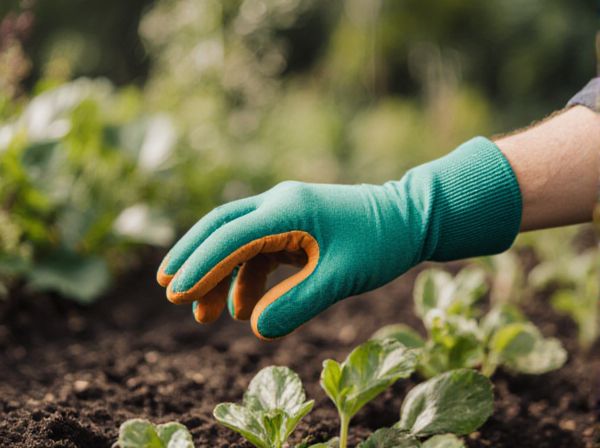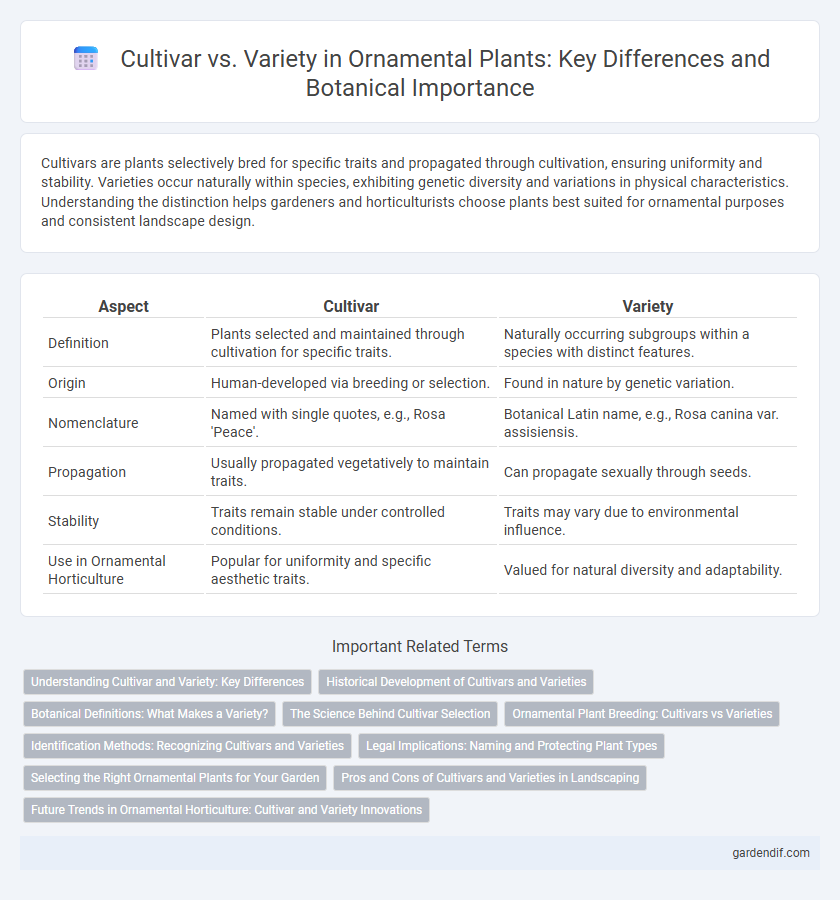
Cultivar vs Variety Illustration
Cultivars are plants selectively bred for specific traits and propagated through cultivation, ensuring uniformity and stability. Varieties occur naturally within species, exhibiting genetic diversity and variations in physical characteristics. Understanding the distinction helps gardeners and horticulturists choose plants best suited for ornamental purposes and consistent landscape design.
Table of Comparison
| Aspect | Cultivar | Variety |
|---|---|---|
| Definition | Plants selected and maintained through cultivation for specific traits. | Naturally occurring subgroups within a species with distinct features. |
| Origin | Human-developed via breeding or selection. | Found in nature by genetic variation. |
| Nomenclature | Named with single quotes, e.g., Rosa 'Peace'. | Botanical Latin name, e.g., Rosa canina var. assisiensis. |
| Propagation | Usually propagated vegetatively to maintain traits. | Can propagate sexually through seeds. |
| Stability | Traits remain stable under controlled conditions. | Traits may vary due to environmental influence. |
| Use in Ornamental Horticulture | Popular for uniformity and specific aesthetic traits. | Valued for natural diversity and adaptability. |
Understanding Cultivar and Variety: Key Differences
Cultivar refers to a plant selected for specific desirable traits maintained through propagation, while variety occurs naturally within a species and differs genetically. Cultivars often originate from human intervention like selective breeding, ensuring uniformity and stability of characteristics. Varieties represent naturally occurring subgroups with distinct features but less genetic control compared to cultivars.
Historical Development of Cultivars and Varieties
Cultivars and varieties have distinct historical developments that reflect human influence on plant breeding and natural evolution. Varieties arise naturally through genetic variation and adaptation over time, whereas cultivars result from deliberate selection and propagation by horticulturists to enhance desirable traits. The cultivation of ornamental plants like roses and orchids has driven the proliferation of cultivars, showcasing targeted breeding efforts compared to the more genetically diverse and naturally occurring varieties.
Botanical Definitions: What Makes a Variety?
A variety in botanical terms refers to a naturally occurring subgroup within a species that exhibits distinct morphological traits and can reproduce true to type through seeds. Cultivars, by contrast, are human-selected or bred plants maintained through propagation for specific ornamental traits, often lacking natural seed stability. Varieties are genetically stable populations found in nature, while cultivars rely on horticultural techniques for trait preservation.
The Science Behind Cultivar Selection
Cultivar selection involves identifying plants with specific, desirable genetic traits achieved through controlled breeding techniques, ensuring uniformity and stability in ornamental characteristics. In contrast, a variety naturally occurs within a species and exhibits genetic variation without human intervention. Understanding the genetic makeup and phenotypic expression in cultivars enables horticulturists to enhance ornamental qualities such as flower color, shape, and disease resistance.
Ornamental Plant Breeding: Cultivars vs Varieties
Ornamental plant breeding distinguishes cultivars and varieties based on genetic stability and selection processes; cultivars are human-selected and maintained through propagation for specific traits, while varieties occur naturally with genetic variation within species. Cultivars often exhibit uniformity and enhanced ornamental features such as flower color, form, or foliage, which are stabilized by clonal propagation techniques. Varieties maintain broader genetic diversity, contributing to adaptability and ecological resilience but may show less uniformity in ornamental characteristics.
Identification Methods: Recognizing Cultivars and Varieties
Identification methods for ornamental plants distinguish cultivars by specific traits stabilized through artificial selection, while varieties naturally exhibit genetic variations within a species. Morphological characteristics, genetic markers, and phenotypic evaluations are commonly used to accurately identify cultivars and varieties. Detailed records and labeling in nurseries support precise recognition, ensuring correct classification for horticultural and breeding purposes.
Legal Implications: Naming and Protecting Plant Types
Cultivars and varieties differ significantly in legal contexts, particularly regarding plant naming and protection rights. Cultivars are legally registered with standardized names under the International Code of Nomenclature for Cultivated Plants (ICNCP), providing exclusive propagation rights that can be protected by Plant Breeders' Rights (PBR) or patents. Varieties, often naturally occurring subsets within species, may not always qualify for such legal protections, making cultivar registration crucial for securing intellectual property and commercial exclusivity in ornamental horticulture.
Selecting the Right Ornamental Plants for Your Garden
Selecting the right ornamental plants involves understanding the difference between a cultivar and a variety; cultivars are specifically bred for desirable traits such as flower color or growth habit, while varieties occur naturally with unique characteristics. Gardeners should choose cultivars for consistent and enhanced aesthetic appeal, ensuring vibrant blooms and uniform growth that suit their landscape design. Considering factors like climate adaptability and maintenance needs helps in selecting the ideal ornamental plants to achieve a thriving, visually striking garden.
Pros and Cons of Cultivars and Varieties in Landscaping
Cultivars in landscaping offer consistent traits and predictable growth patterns, making them ideal for uniform designs and specific aesthetic goals, but they may lack genetic diversity and resilience compared to varieties. Varieties provide greater adaptability and ecological benefits due to their genetic variation, yet they can result in less uniformity and unpredictable characteristics that challenge precise landscape design. Choosing between cultivars and varieties depends on balancing the need for reliability and visual consistency against the benefits of biodiversity and environmental adaptability.
Future Trends in Ornamental Horticulture: Cultivar and Variety Innovations
Future trends in ornamental horticulture emphasize the development of cultivars with enhanced traits such as increased disease resistance, drought tolerance, and extended flowering periods. Advances in genetic editing and biotechnology enable the creation of novel varieties that meet specific aesthetic and environmental demands. Innovative breeding techniques accelerate the production of cultivars and varieties that contribute to sustainable landscaping and urban greening initiatives.
Cultivar vs Variety Infographic

 gardendif.com
gardendif.com